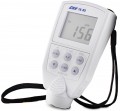The type determines how the thickness gauge works.
—
Eddy current. Devices, the operation of which is based on the fact that the sensor, using an alternating electromagnetic field, induces special currents in the metal under the paint — the so-called. vortex. Such currents create their own electromagnetic radiation, their power — and, accordingly, the power of secondary radiation — depends on the distance between the sensor and the metal, that is, on the thickness of the paintwork. Devices of this type can be used with any conductive materials, but it is believed that they work best with non-
ferrous metals(in particular, aluminium).
—
Electromagnetic. Devices operating on the basis of basic electromagnetic phenomena — magnetic induction or the Hall effect. Simply put, the sensor of such a thickness gauge creates a magnetic field, when a magnetic object enters the sensor’s coverage area, the field characteristics change, and these changes determine the distance to the object — in this case, this distance corresponds to the thickness of the paintwork, because the sensor is pressed tightly during measurements to the surface. Electromagnetic devices do a better job with steel and other
ferrous metals than eddy current ones, however, such devices cannot work with non-magnetic materials.
— Electromagnetic / eddy
...current. Universal thickness gauges that combine both of the above principles of operation and are capable of using either of them. At the same time, some models are able to automatically determine the type of metal and turn on the appropriate mode of the sensor. This is the most convenient option from the user's point of view, despite the fact that it is not so expensive. As a result, universal devices are very popular today.The maximum coating thickness that the instrument can detect when measuring non-ferrous metals such as aluminium alloys. With a larger coating thickness, the thickness gauge sensor simply cannot “catch” on the metal surface under the paint, and effective measurement will not be possible. This parameter is indicated in micrometers — thousandths of a millimetre; the larger it is, the more versatile the device is, the wider the possibilities for its use. On the other hand, a large maximum measurement thickness can adversely affect the accuracy when measuring small values.
For modern thickness gauges, the maximum thickness
up to 1000 microns is considered small,
from 1000 to 1500 microns — small,
from 1500 to 2000 microns — medium,
more than 2000 microns — significant. In the most advanced professional-level models, this figure can reach 20 – 30 cm.

